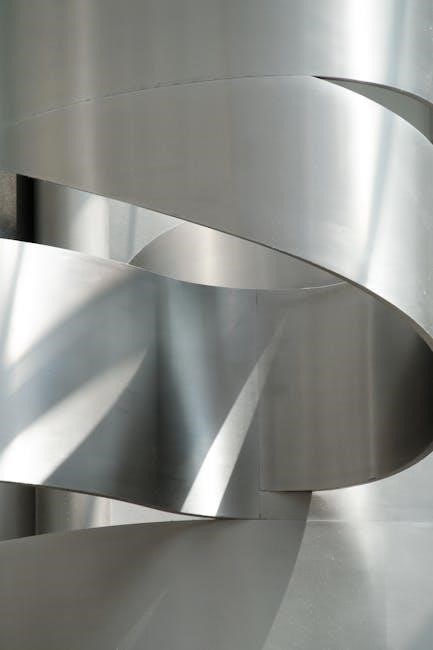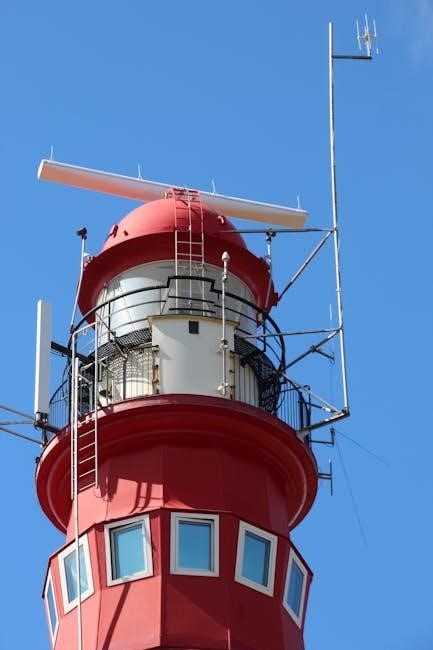Vertical metal siding offers durability, low maintenance, and a modern aesthetic, making it ideal for various structures. This guide provides comprehensive steps and expert tips for successful installation, ensuring a professional finish and long-term performance for your building.
Overview of Vertical Metal Siding
Vertical metal siding is a durable, low-maintenance option offering a modern, sleek appearance. Available in materials like corrugated metal, ribbed steel, and smooth aluminum, it provides versatility for various architectural designs. Its vertical orientation enhances structural appeal and simplifies installation. Energy-efficient and weather-resistant, vertical siding is ideal for homes, garages, and commercial buildings, combining functionality with aesthetic appeal for long-lasting performance.
Importance of Proper Installation
Proper installation of vertical metal siding is crucial to prevent fire hazards, ensure structural integrity, and maintain a professional appearance. Incorrect flashing or electrical connections can lead to safety risks, while uneven surfaces may cause distortion. Following guidelines ensures durability, weather resistance, and aesthetic appeal, avoiding costly repairs and enhancing your building’s long-term performance and safety.
Preparation for Installation
Check the wall condition to ensure it is even and stable. Use a level to verify surface alignment and address any unevenness before proceeding with installation.
Checking the Wall Condition
Before installing vertical metal siding, inspect the wall for cracks, rot, or uneven surfaces. Use a level to ensure the surface is even and plumb. Address any damage or irregularities by repairing cracks or adding shims to level the wall. Ensure the wall is clean, dry, and free from debris to guarantee proper adhesion and a smooth installation process.
Tools and Materials Needed
To install vertical metal siding, you’ll need a sliding miter saw or carbide-tipped saw for cutting, a utility knife for trimming, and screwdrivers or drills for fastening. Materials include metal siding panels, furring strips, J-channel trim, flashing, screws, and weatherproof sealants. Ensure all tools are in good condition and materials are compatible with your siding type for a secure and durable installation.
Building Out Windows and Doors
Building out windows and doors is an optional but recommended step to enhance the finished appearance. Use trim boards to create a solid base for the J-Channel, ensuring a flush installation. This step hides the back side of the J-Channel and provides a clean surface for the siding panels to butt against, improving both functionality and aesthetics.
Materials and Accessories
Vertical metal siding systems include panels, trim, flashing, and furring strips. Panels come in corrugated, ribbed, or smooth designs, while accessories ensure secure, weather-tight installation and a polished look.
Types of Vertical Siding Panels
Vertical siding panels are available in various styles, including corrugated, ribbed steel, and smooth aluminum. Corrugated panels offer a traditional look, while ribbed steel provides strength and durability. Smooth aluminum panels deliver a modern, sleek appearance. Each type comes in multiple colors and finishes, ensuring versatility to suit different architectural designs and preferences for both residential and commercial applications.
Trim, Flashing, and Other Accessories
Trim and flashing are essential for a seamless vertical metal siding installation. J-Channel trim is used to hide panel edges, while flashing ensures water tightness around windows and doors. Metal flashing is preferred for fire safety, and shims or furring strips may be needed for uneven surfaces. Accessories like utility channels and decorative trim enhance both functionality and aesthetics, ensuring a polished finish.
Furring Strips for Surface Preparation
Furring strips are essential for creating a smooth, even surface for vertical metal siding. Typically 1×2 or 1×3 wood strips, they are spaced 16 to 24 inches on center and run perpendicular to the siding direction. This ensures proper panel alignment and prevents warping or distortion. Properly installed furring strips are crucial for achieving a professional, long-lasting finish.

Installation Steps
Start by ensuring the surface is prepared and level. Begin installation at a corner, aligning panels vertically. Secure each panel tightly, working row by row, using a level to maintain proper alignment. Handle edges and corners with precision, and use appropriate fasteners to prevent gaps or unevenness for a seamless finish.
Starting the Installation Process
Begin by ensuring the wall surface is level and secure. If necessary, install furring strips to create an even base. Start at a corner, aligning the first panel vertically. Use a level to ensure proper alignment, then secure the panel with approved fasteners. Proceed row by row, maintaining consistent spacing and alignment for a professional finish. Work methodically to avoid misalignment and ensure structural integrity.
Aligning and Securing Panels
Ensure panels are aligned vertically and horizontally using a level. Fasten each panel at the top and bottom edges, maintaining manufacturer-recommended spacing. Secure with approved fasteners, ensuring they are snug but not over-tightened. Check each row for proper alignment before proceeding. This method guarantees a straight, secure installation, preventing gaps and ensuring a professional finish.
Handling Corners and Edges
Use trim boards or J-Channel to create a seamless transition at corners and edges. Install outside and inside corner trims to ensure panels align smoothly. Align panels with the trim, securing them firmly to avoid gaps. Flashing should be applied around edges near windows and doors to prevent water infiltration. Proper handling ensures a professional, weather-tight finish.
Cutting and Fitting Panels
Cut metal siding using a sliding miter saw or carbide-tipped blade. Start cuts from the edge, ensuring straight lines. Fit panels around obstacles like windows and doors precisely for a seamless look.
Methods for Cutting Metal Siding
Cutting metal siding requires precision to ensure clean edges and accurate fits. Use a sliding miter saw or a circular saw with a carbide-tipped blade for straight cuts. Start cuts from the edge of the panel to maintain control. For curved cuts, consider a nibbler or metal shears. Always wear safety goggles and a dust mask to protect yourself from debris. Proper cutting techniques are essential for a professional-looking installation.
Fitting Panels Around Windows and Doors
Fitting panels around windows and doors requires precision to ensure a seamless appearance. Build out the areas with shims, wood lath, or furring strips to create a stable surface. Use trim boards to hide the back side of the J-channel and provide a clean finish. This optional step enhances the overall look and ensures panels align properly with the casing, creating a professional and polished result.
Dealing with Uneven Surfaces
Dealing with uneven surfaces requires careful preparation to ensure a smooth installation. Furring strips, typically 1×2 or 1×3 wood, are installed perpendicular to the siding direction, spaced 16 to 24 inches on center. For vertical siding, horizontal furring strips create a stable base. Shims can be used to fill gaps and level the surface. Always inspect the wall for irregularities and plan strip placement accordingly. Use a level, saw, and nails to secure strips, ensuring panels align properly for a professional finish. For concrete walls, consider appropriate anchors. While insulation or vapor barriers aren’t specified, they may enhance energy efficiency. Address minor unevenness with shims and major issues separately. Proper preparation ensures the siding appears seamless and durable.

Safety Considerations
Protect yourself by wearing gloves, safety glasses, and a dust mask. Ensure proper electrical setups to avoid fire hazards. Use non-flammable materials and keep fire extinguishers nearby.
Protecting Yourself During Installation
Wear protective gear, including gloves, safety glasses, and a dust mask, to prevent injuries from sharp metal edges and debris. Ensure proper footing and use ladders safely to avoid falls. Keep electrical tools away from water and ensure all connections are secure to prevent shocks. Maintain a clean workspace to reduce tripping hazards and store tools properly when not in use.
Preventing Fire Hazards
Ensure all electrical connections and wire junctions are enclosed in non-flammable boxes to prevent fire risks. Keep heat sources away from metal siding, as it can conduct heat. Use fire-resistant materials for insulation and flashing near potential ignition sources. Regularly inspect electrical systems and ensure proper ventilation to minimize fire hazards during and after installation.

Finishing Touches
Complete the project by inspecting for gaps or imperfections, touching up scratches, and securing all trim. Ensure a clean, professional finish for lasting durability and appeal.
Final Inspection and Touch-ups
After installation, conduct a thorough inspection to ensure all panels are securely fastened and properly aligned. Check for gaps, dents, or scratches that may require touch-ups. Verify that all trim, flashing, and accessories are correctly installed and sealed. Address any imperfections by repainting or replacing damaged sections. Finally, clean the siding to remove dirt or debris, ensuring a pristine finish that enhances the building’s appearance and durability.
Adding Trim and Finishing Elements
Install trim around windows, doors, and corners to create a polished look and ensure weather-tight seals. Use J-Channels or L-Channels to cover raw edges of siding panels, enhancing both functionality and aesthetics. Finish with decorative elements like fascia and soffit trim for a cohesive appearance. Properly securing all trim ensures longevity and protects against elemental damage, completing the siding system effectively.
Maintenance and Care
Regular cleaning with mild detergent prevents dirt buildup. Inspect for dents or scratches and touch up promptly to prevent rust. Keep surroundings clear to avoid damage.
Regular Maintenance Tips
Regularly wash the siding with a mild detergent to remove dirt and grime. Inspect for dents, scratches, or rust, and touch them up immediately. Trim nearby vegetation to prevent damage. Ensure proper drainage to avoid water pooling. Check for loose panels and tighten as needed. Avoid using harsh chemicals or abrasive materials that could damage the finish. Regular maintenance ensures longevity and preserves the siding’s appearance.
Cleaning and Preserving the Siding
Use a mild detergent and water to clean vertical metal siding, avoiding harsh chemicals or abrasive materials. Regularly remove dirt and debris to prevent staining. For stubborn stains, mix baking soda and water to create a gentle paste. Avoid using high-pressure washes, which can damage the finish. Touch up scratches or dents promptly to prevent rust. Preserve the siding’s appearance by rinsing thoroughly after cleaning to remove soap residue.

Additional Resources and Troubleshooting
Consult manufacturer manuals or online guides for troubleshooting tips. Websites offer step-by-step solutions and expert advice for common installation issues with vertical metal siding.
Where to Find More Information
For detailed guidance, refer to manufacturer manuals or online installation guides. Websites like MetalSidingGuide.com and EDCOproducts.com offer comprehensive resources, including PDF manuals and troubleshooting tips. Additionally, forums and DIY communities provide real-world advice and solutions for common installation challenges. These resources ensure you have access to expert knowledge and practical solutions for a successful vertical metal siding project.
Troubleshooting Common Issues
Common issues during vertical metal siding installation include uneven surfaces, misaligned panels, and fire hazards from improper electrical setups. Ensure all wire junctions are enclosed in non-flammable boxes; Address uneven surfaces with furring strips or shims. For warped panels, check alignment and secure properly. Consult manufacturer guides or online resources like MetalSidingGuide.com for detailed solutions and expert advice to resolve installation challenges effectively.
